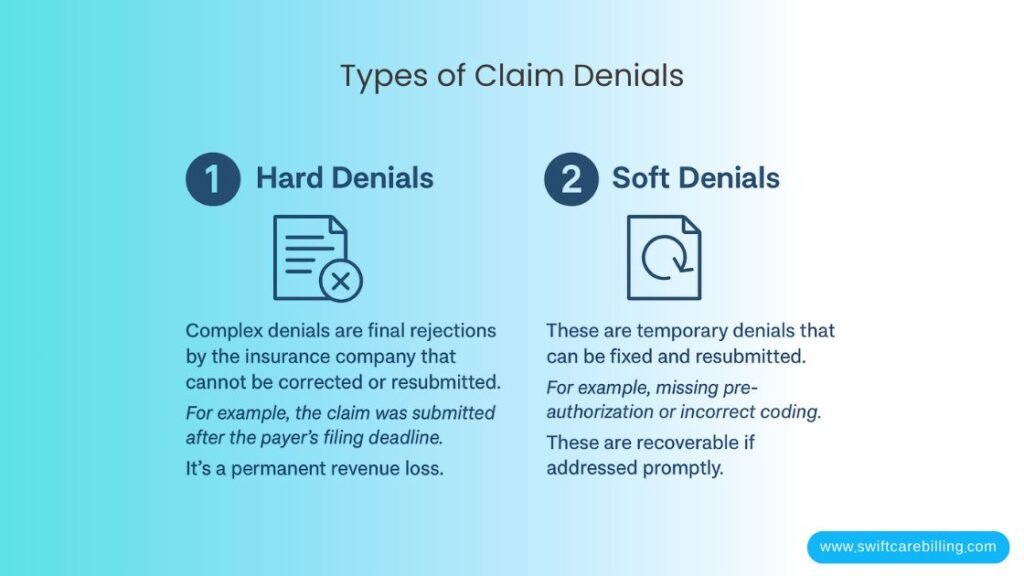When it comes to running a medical practice, you expect to get paid for the services you provide. But insurance companies don’t always make it easy.
Claims can come back denied for dozens of reasons — from something as small as a missing digit in a date of birth to complex policy rules.
This is where denial management steps in.
It is your revenue rescue team that finds a way out of why claims were denied, fixes the problem, and makes sure it doesn’t happen again.
In this blog, we’ll break down what denial management is, why it matters, how it works, and how you can keep your denial rate as low as possible.
What Is Denial Management?
In medical billing, denial management is the process of identifying, analyzing, and resolving insurance claim denials.
It’s not just about reworking denied claims — it’s also about preventing future denials by fixing root causes.
· Without denial management, Denials pile up, cash flow suffers, and revenue is lost permanently.
· With denial management, Claims get fixed and paid faster, and your practice’s revenue cycle stays healthy.
Why Denial Management Is a Big Deal
Denials are more than a paperwork headache; they’re a financial threat.
· According to MGMA, 65% of denied claims are never reworked.
· The cost to rework a single claim ranges from $25 to $118 in staff time.
· Even a 1% increase in denial rate can cost a mid-sized practice tens of thousands per year.
For example, if your practice bills $500,000 per month and your denial rate is 10%, that’s $50,000 in denied claims monthly. If you never recover 65% of that, you’re losing $390,000 a year.
Types of Claim Denials

Not all denials are created equal. They typically fall into two categories:
1. Hard Denials
Complex denials are final rejections by the insurance company that cannot be corrected or resubmitted.
For example, the claim was submitted after the payer’s filing deadline.
It’s a permanent revenue loss.
2. Soft Denials
These are temporary denials that can be fixed and resubmitted.
For example, missing pre-authorization or incorrect coding.
These are recoverable if addressed promptly.
Top Reasons Claims Get Denied
Understanding why payers reject or deny claims is the first step toward fixing the problem — and preventing it in the future.
Here are common denial reasons — and how they link back to hard or soft denials.
Incorrect Patient Information
Even minor errors like a misspelled name, wrong date of birth, or an outdated insurance ID can lead to instant rejections. These are usually easy to fix, but they slow down payments and create unnecessary work.
Eligibility Issues
If a patient’s coverage is inactive or doesn’t match the date of service, the claim will bounce back. This often happens when eligibility isn’t verified before the visit, leaving the practice unpaid and the patient with the bill.
Missing Authorizations
Many payers require pre-approval for certain services, such as surgeries, advanced imaging, or specialized therapies. Skipping this step almost always results in a denial, and in some cases, the service won’t be paid at all.
Coding Errors
Using the wrong CPT, HCPCS, or ICD-10 code — or pairing them incorrectly — can trigger denials. These errors are typically fixable, but they delay reimbursement and may flag the claim for further review.
Timely Filing Issues
Every payer has a submission deadline, often 90–180 days from the date of service. If you miss it, the denial is final and the revenue is gone. This is one of the most preventable — yet costly — mistakes.
Bundling/Unbundling Mistakes
Billing separately for procedures that should be combined under one code, or failing to separate services when required, leads to payment rejections. Knowing payer-specific bundling rules is key.
Medical Necessity Disputes
Payers may reject claims if they believe the service wasn’t clinically necessary based on the diagnosis provided. Overturning these denials requires strong documentation that supports the need for treatment.
The Denial Management Process
A strong denial management process is part detective work, part prevention plan. Each step matters — miss one, and you risk losing revenue permanently. Here’s how it typically works:
Step 1: Identify the Denial
Before you can fix a denial, you need to know exactly what went wrong. This means catching denials as soon as they occur and understanding the reason codes attached to them.
· Review EOBs (Explanation of Benefits) or ERAs (Electronic Remittance Advice).
· Check the Claim Adjustment Reason Codes (CARCs) and Remittance Advice Remark Codes (RARCs).
Step 2: Investigate the Root Cause
Think like a detective — trace the denial back to its origin. Was it a front-desk issue, a coding slip, or a payer-specific rule?
· Was the error made during patient intake?
· Did the coding team make a mistake?
· Is it a payer-specific policy issue?
Step 3: Fix the Issue
Once you know the cause, take immediate action to correct it. Speed matters — every day of delay means more time without payment.
· Correct patient demographics.
· Add missing documentation.
· Fix coding errors.
· Request retroactive authorizations if possible.
Step 4: Resubmit or Appeal
Now it’s time to get the claim back in play. Some denials can be resubmitted with corrections, while others require a formal appeal.
· For soft denials, resubmit after correction.
· For disputed denials, file a formal appeal with detailed justification and supporting documentation.
Step 5: Prevent Recurrence
The best denial is the one that never happens. Use every denial as a learning opportunity to improve processes and train your team.
· Train staff.
· Update processes.
· Use denial tracking reports to spot patterns.
Best Practices for Denial Management

If you want to keep your denial rate below 5% — the industry gold standard — your approach needs to be proactive, precise, and consistent. Here’s how to make it happen:
Verify Eligibility Before Every Appointment
Run a real-time eligibility check for every patient, even repeat visitors. Confirm active coverage, copays, deductibles, and service-specific benefits. Flag any changes before the visit to avoid billing surprises.
Use Advanced Claim Scrubbers
Implement claim-scrubbing tools within your EHR or practice management system to automatically detect missing modifiers, mismatched codes, or formatting errors before the claim leaves your office.
Train Staff on Payer Rules Regularly
Schedule quarterly training sessions for billing and front-desk staff focused on new CPT/ICD-10 updates, payer-specific requirements, and common denial codes. Provide quick-reference cheat sheets for high-volume services.
Track Key Performance Indicators (KPIs)
Monitor denial rate, first-pass resolution rate, appeal success rate, and days in A/R. Review these metrics monthly to identify problem areas and address them before they affect cash flow.
Maintain a Payer Rulebook
Create a centralized, easy-to-access document (digital or printed) listing each payer’s timely filing limits, pre-authorization rules, bundling policies, and special documentation requirements. Update it as soon as a policy changes.
Leverage Analytics for Denial Trends
Use reporting tools to categorize denials by reason, payer, and service type. Identify recurring patterns — such as high denial rates for specific CPT codes — and adjust workflows to eliminate those errors.
KPIs to Measure Denial Management Success
To see if your denial management strategy works, track these:
· Denial Rate – Target under 5%.
· First-Pass Resolution Rate – Aim for 90–95%.
· Appeal Success Rate – Higher means better recovery.
· Days in A/R – Lower is better.
· Cost per Reworked Claim – Keep it minimal.
Final Thoughts
Denial management isn’t just “fixing rejections.” It’s a revenue protection strategy.
Without it, you’re leaving serious money on the table.
With it, you improve cash flow, reduce write-offs, and strengthen your practice’s financial health.
A good denial management process is proactive, not reactive — identify and address the causes, and put safeguards in place. That’s how you turn denials into dollars.
Every denied claim is lost revenue, unless you have the right team on your side.
Swiftcare Billing USA helps you prevent, fix, and win back claims with expert denial management, advanced tools, and payer-specific know-how.
Let’s turn your denials into consistent, predictable cash flow.
Frequently Asked Questions (FAQs)
What‘s the difference between a denial and a rejection?
A denial happens after the payer processes a claim, but payment is refused (e.g., lack of medical necessity). A rejection means the claim never made it through initial processing, often due to formatting or missing information. Rejections must be corrected and resubmitted; denials require appeal or rework.
How do hard and soft denials affect my revenue?
Complex denials are permanent — once they happen, that money is gone. Soft denials are temporary and can be corrected and resubmitted. The goal is to catch soft denials early before they turn into write-offs.
What’s considered a reasonable denial rate?
Industry benchmarks suggest keeping your denial rate under 5% of total claims. Anything higher means you’re likely losing revenue unnecessarily.
How soon should denied claims be addressed?
Ideally, within 48 hours of receiving the denial. The longer you wait, the harder it becomes to recover the payment — and you risk missing payer deadlines for appeals.
What’s the most common reason for claim denials?
Incorrect patient information is surprisingly the top culprit. Typos, wrong birth dates, and outdated insurance IDs can all trigger instant denials.
Can technology reduce denials?
Yes — claim scrubbers, eligibility verification tools, and denial analytics software can catch common mistakes before submission and spot recurring patterns that cause revenue loss.
How do I know if my denial management process is working?
Track key metrics like denial rate, first-pass resolution rate, appeal success rate, and days in A/R. If those numbers improve over time, your process is on the right track.
What’s the cost of not managing denials?
It adds up fast. If you bill $500,000 monthly and have a 10% denial rate, that’s $50,000 in claims denied every month. If 65% of those never recovered, you’re losing $390,000 annually.
Should denial management be handled in-house or outsourced?
It depends on claim volume, staff expertise, and budget. Large practices may benefit from outsourcing to specialized billing companies, while smaller practices can often manage denials effectively in-house with the right tools and training.
How do I prevent the same denial from happening again?
Document every denial reason, update your internal processes, and train staff regularly. Prevention is cheaper — and faster — than fixing denials after the fact.

